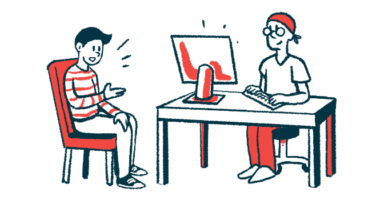Upper Body Training Improves Motor Skills, Attention Span

Repeated and well-structured upper body training of girls and women with Rett syndrome improves reaching and grasping ability, attention span, and reduced repetitive movements, a study suggests
These findings highlight the relationship between attention and motor abilities, which has implications for the development of motor rehabilitation programs for these patients, the researchers said.
The study, “Repeated motor training on attention reaching skills and stereotypies in Rett Syndrome,” was published in the journal Movement Disorders Clinical Practice.
Rett syndrome, which affects mostly females, is characterized by delays in motor skills in infancy, such as crawling or sitting, followed by a decline in speech and cognition, with increased stereotypic (repetitive) hand movements and breathing problems. Later, seizures and movement problems are common.
During early development, many Rett patients lose purposeful hand movements (the ability to reach and grasp objects).
However, few studies have investigated the impact of structured and specific training targeting upper limb motor skills to improve reaching and grasping abilities.
Researchers based at the Research and Innovation Airett Center in Italy designed a repeated motor training regimen and examined its effects on reaching skills, repetitive movements, and attention in a group of 28 girls and women, ages 4 to 22, living with Rett.
All participants underwent general motor assessments using the Vineland Adaptive Behavior Scale (VABS), the Rett Assessment Rating Scales (RARS), and a series of tests for reaching, stereotypic movements, and attention.
An initial pre-training assessment was followed by a month of training, five days a week, then a second assessment period. Training and assessments were repeated twice more, for a total of three training sessions and three post-training evaluations.
A teacher or educator carried out the motor training in the patient’s home. Participants were seated in a chair, and their dominant arm was placed on the table and asked to perform reaching tasks — touching food or an object and holding a bottle or cup. The reaching tasks proceeded from the first task to the second and so on.
If the participant spontaneously reached to touch the object for five consecutive days for a week, it was defined as a correct reply to proceed to the next task. The object was placed on the table at 20 cm (about 8 inches) from the participant. If the object was touched and the distance between the participant’s hand and object decreased for 10 consecutive days, it was considered a correct reply to proceed to the next task.
Based on assessments after each training session, the reaching skills improved over time. The distance between the participants’ hands and objects before training was significantly different from those after the first training session. Reaching skills improved significantly after each successive training session compared to values after the first month of training.
Compared to before training, attention span in seconds significantly improved after each successive training session, showing “long-term improvements in the attention ability,” the team wrote.
There also was a significant reduction in the intensity of repetitive movements after the second and third assessment periods compared to before training, and between the first and second assessments, indicating that “the intensity of stereotypics decreases in the first phase of motor training and remains stable in the last phases,” the researchers added.
Regarding the VABS test, compared to pre-training, there was significant improvement during all three post-training assessments and a statistically significant difference comparing the second and third VABS assessments to the first one. Similar results were seen using the motor subscales of RARS.
Of note, the team found that age had no effect on the outcomes, despite the broad age range of the group.
“This study shows that repeated motor training increases attention, reaching skills and reduces hand stereotypies,” the authors concluded. “These findings collectively highlight the interplay between attention and motor systems, which in turn has practical implications for developing and design of motor rehabilitation programs for patients with [Rett].”






